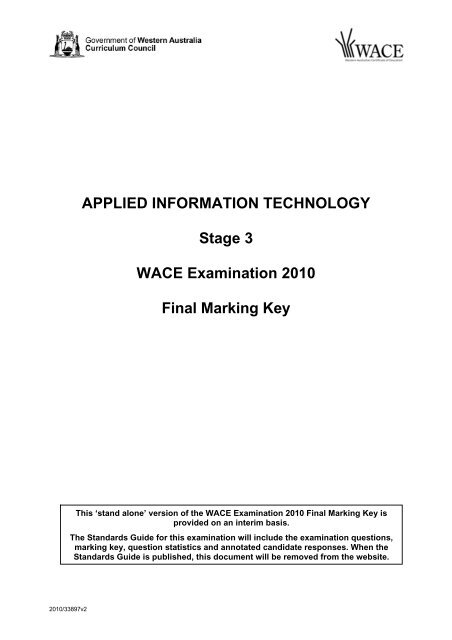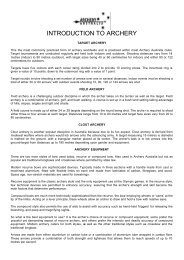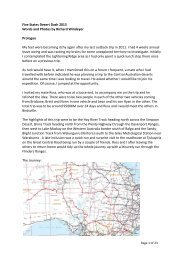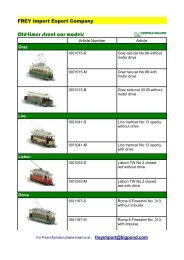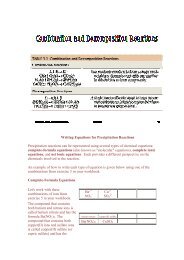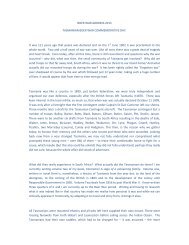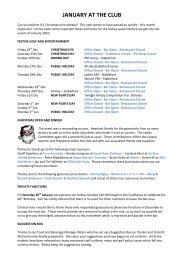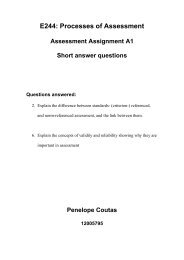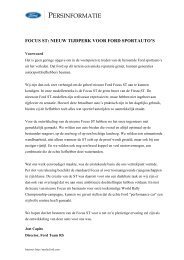Stage 3 2010 WACE Written Examination Marking Key
Stage 3 2010 WACE Written Examination Marking Key
Stage 3 2010 WACE Written Examination Marking Key
You also want an ePaper? Increase the reach of your titles
YUMPU automatically turns print PDFs into web optimized ePapers that Google loves.
<strong>2010</strong>/33897v2<br />
APPLIED INFORMATION TECHNOLOGY<br />
<strong>Stage</strong> 3<br />
<strong>WACE</strong> <strong>Examination</strong> <strong>2010</strong><br />
Final <strong>Marking</strong> <strong>Key</strong><br />
This ‘stand alone’ version of the <strong>WACE</strong> <strong>Examination</strong> <strong>2010</strong> Final <strong>Marking</strong> <strong>Key</strong> is<br />
provided on an interim basis.<br />
The Standards Guide for this examination will include the examination questions,<br />
marking key, question statistics and annotated candidate responses. When the<br />
Standards Guide is published, this document will be removed from the website.
APPLIED INFORMATION TECHNOLOGY 2 MARKING KEY<br />
STAGE 3<br />
Section One: Multiple-choice 20 Marks<br />
Question Answer<br />
1 a<br />
2 d<br />
3 b<br />
4 c<br />
5 a<br />
6 a<br />
7 c<br />
8 c<br />
9 c<br />
10 c<br />
11 a<br />
12 b<br />
13 b<br />
14 d<br />
15 c<br />
16 b<br />
17 b<br />
18 d<br />
19 c<br />
20 c
APPLIED INFORMATION TECHNOLOGY 3 MARKING KEY<br />
STAGE 3<br />
Section Two: Short answer 15% (30 Marks)<br />
Question 21 (4 marks)<br />
Outline four ways in which the effective use of ICT can increase the productivity of<br />
manufacturing industries.<br />
Description Marks<br />
One mark for each valid response to a maximum of 4 marks<br />
1. It reduces costs by increasing the capability of machinery, thus reducing the<br />
need for human input.<br />
2. It increases flexibility in production planning and scheduling, reducing lead<br />
times and improving responsiveness to customer needs.<br />
3. It facilitates accurate and fast modelling of industrial processes, enabling<br />
their optimisation in various ways. Responsive<br />
4. It improves communication between team members, record-keeping, etc.<br />
0–4<br />
5. Rapid prototyping and modelling<br />
6. Access global markets for sales, accessing resources and research<br />
Marker’s notes for other possible answers:<br />
Total 4<br />
Question 22 (5 marks)<br />
(a) Define ‘inclusivity’ as it applies to the design of an ICT product or service. (1 mark)<br />
Description Marks<br />
One mark for a clear definition<br />
Inclusivity in design means ensuring that a product or system is accessible to as 0-1<br />
many users as possible.<br />
Total 1<br />
(b) A design needs to be made inclusive of an ageing population. Identify four barriers to<br />
inclusivity and outline their solutions. (4 marks)<br />
Description Marks<br />
One mark for each valid response to a maximum of 4 marks<br />
1. Compensate for failing eyesight, e.g. by providing a zoom facility.<br />
2. Compensate for failing hearing, e.g. by providing visual alternatives to sound.<br />
3. Compensate for failing dexterity, e.g. by providing large buttons/icons to click<br />
on.<br />
4. Compensate for failing memory, e.g. by storing relevant important data.<br />
5. Compensate for failing mobility, e.g. by providing remote control facilities.<br />
0–4<br />
Marker’s notes for other possible answers:<br />
Total 4
APPLIED INFORMATION TECHNOLOGY 4 MARKING KEY<br />
STAGE 3<br />
Question 23 (6 marks)<br />
(a) Describe four aspects of an ICT project that need to be monitored and documented<br />
over the course of its development. (4 marks)<br />
Description Marks<br />
One mark for each type of information with a valid justification to a<br />
maximum of 4 marks<br />
1. Project spending, to check that the budget is not exceeded.<br />
2. Client expectations, to check if design changes are needed.<br />
3. Personnel situation, to ensure that the required skills and manpower is<br />
available.<br />
4. Provision of hardware and software, to ensure that the goals are achievable. 0–4<br />
5. Timelines , to ensure that they are being met or progress made.<br />
Marker’s notes for other possible answers:<br />
Total 4<br />
(b) Define ‘top-down’ as a project management strategy. (1 mark)<br />
Description Marks<br />
One mark each for a clear explanation<br />
A top-down project starts with a high-level specification of the system being<br />
0-1<br />
built, and iteratively refines this specification until all parts of the specification<br />
can be implemented directly.<br />
Total 1<br />
(c) Define ‘bottom-up’ as a project management strategy. (1 mark)<br />
Description Marks<br />
One mark each for a clear explanation<br />
A bottom-up project starts by implementing a range of low-level facilities and<br />
0-1<br />
then iteratively building larger sub-systems using these facilities, until finally the<br />
entire system can be assembled.<br />
Total 1<br />
Question 24 (2 marks)<br />
Describe briefly the type of network traffic the following protocols control.<br />
(a) HTTP (1 mark)<br />
Description Marks<br />
HTTP controls, establish connection, allows web page traffic or Hyper text<br />
Note to markers: No mark for correct expansion of the acronym<br />
0 -1<br />
Total 1
APPLIED INFORMATION TECHNOLOGY 5 MARKING KEY<br />
STAGE 3<br />
(b) SMTP (1 mark)<br />
Description Marks<br />
SMTP controls email or small messaging<br />
Note to markers: No mark for correct expansion of the acronym<br />
0 -1<br />
Total 1<br />
Question 25 (11 marks)<br />
You wish to outsource the purchasing of a number of computers.<br />
(a) List four criteria you would use to select a company to supply the computers. (4 marks)<br />
Description<br />
One mark per valid criteria to a maximum of 4 marks<br />
Marks<br />
Cost<br />
Machine performance against industry benchmarks<br />
TCO – Total Cost of Ownership<br />
Vendor history<br />
<br />
<br />
Vendor ability to support equipment<br />
Reliability of equipment<br />
0–4<br />
Reputation of vendor and equipment<br />
Added services<br />
Management<br />
Training<br />
support<br />
Total 4<br />
(b) To minimise the cost you consider reusing old computer components and peripherals in<br />
or with your new computers. Describe, with a suitable example, two problems that may<br />
be encountered. (4 marks)<br />
Description<br />
One mark for a valid issue and one mark for an example of the issue to a<br />
maximum of 4 marks<br />
Marks<br />
Compatibility of old hardware with new hardware – graphics cards<br />
won’t fit new slots.<br />
Compatibility of old software with new operating systems – 64bit vs<br />
32 bit<br />
0–4<br />
No drivers for old peripherals.<br />
No plugs / IO ports for equipment such as no LPT ports on new<br />
hardware for printers.<br />
Total 4<br />
(c) A company does not have an IT support department. Describe three ways in which it<br />
could support its staff that use computers. (3 marks)<br />
Description<br />
One mark for a valid answer to a maximum of 3 marks – accept list<br />
Marks<br />
Forums<br />
Bulletin boards<br />
On-line tutorials<br />
0–3<br />
Live chats<br />
Support through a local company – on call<br />
Power users access to
APPLIED INFORMATION TECHNOLOGY 6 MARKING KEY<br />
STAGE 3<br />
Total 3<br />
Question 26 (2 marks)<br />
A large international company has imposed a ban on accessing social networking sites from its<br />
computer networks. The employees would like to have this ban lifted.<br />
List and justify two benefits that the company could gain from allowing its staff to access social<br />
networking sites.<br />
Description<br />
One mark for each benefit with a valid justification to a maximum of 2<br />
marks<br />
Marks<br />
<br />
<br />
Forums to get information<br />
Collaborate with others at school/work or around the world.<br />
0–2<br />
Share work or problems with others<br />
Create interest groups – chess club, rocket clubs etc.<br />
Total 2
APPLIED INFORMATION TECHNOLOGY 7 MARKING KEY<br />
STAGE 3<br />
Section Three: Extended answer 25% (50 Marks)<br />
Question 27 (25 marks)<br />
Firefly Fine Dining is an international restaurant chain. It has restaurants situated on almost<br />
every continent and in smaller nations located in the Caribbean Sea and the Pacific and Indian<br />
Oceans. Each restaurant has been positioned in popular tourist areas. The management of<br />
Firefly wants all transactions conducted at the restaurants sent to its central database at the<br />
close of each restaurant’s business day. In addition, the management wants each restaurant to<br />
send all of its data files (which record sales, customer information, employee timesheets,<br />
payments made and supplies ordered) to its head office in Perth to be stored on the company’s<br />
server.<br />
(a) All files from each location must be sent across the internet. Describe what the<br />
company could do to reduce the cost and the time taken to transmit each file. (4 marks)<br />
Description Marks<br />
Describes a way in which the cost and the time taken to transmit data files<br />
4<br />
across the internet are reduced (see notes below for possible reasons).<br />
Outlines briefly a way in which the cost and the time taken to transmit data<br />
3<br />
files across the internet could be reduced.<br />
Makes generalised comments that suggest a way in which the cost and the<br />
time taken to transmit data files across the internet could be reduced.<br />
or<br />
Describes a way in which the cost or the time taken to transmit data files<br />
across the internet is reduced (see notes below for possible reasons).<br />
Outlines briefly a way in which the cost or the time taken to transmit data files<br />
1<br />
across the internet could be reduced.<br />
Limited response. 0<br />
Total 4<br />
Markers Notes:<br />
Zip / Compressed files<br />
File formats, csv / xlsx, text, rtf, doc<br />
Time – off peak<br />
Network / Internet / Server speeds<br />
Incremental backup.<br />
Automation<br />
Markers Notes:<br />
<br />
<br />
2
APPLIED INFORMATION TECHNOLOGY 8 MARKING KEY<br />
STAGE 3<br />
(b) The company’s head office wants to conduct a video conference meeting with all of its<br />
managers at the same time. Discuss four issues that would affect the success of the<br />
conference and suggest alternative methods that would address these issues. (8 marks)<br />
Description<br />
One mark for each valid issue and one mark for an alternative, to a<br />
maximum of 8 marks<br />
Marks<br />
Time delays between sites – do a number of conferences depending<br />
on continent.<br />
Language barriers – interpreters<br />
Bandwidth issues, some using satellites causing lag or inability to<br />
carry signal. Use phones in low bandwidth areas<br />
0–8<br />
Software not the same.<br />
Setting up computers to do the conference<br />
Establishing video conference equipment<br />
Time zones<br />
Cultural – language, accents<br />
Total 8<br />
(c) Some of the information that is sent from various locations around the world to the head<br />
office is confidential. Explain four methods that would ensure the security and integrity<br />
of the data on a PC before it was sent. (8 marks)<br />
Description<br />
Two marks per valid issue with an explanation, 1 mark just for issues with<br />
no explanation. Maximum 8 marks.<br />
Marks<br />
Encrypt data before being sent to deny access<br />
Passwords used on PC ends to prevent access<br />
Secure PCs away from customer access<br />
0–8<br />
Firewalls on PC to stop access<br />
Anti-malware on PCs to prevent access<br />
Virus protection<br />
Levels of access or authorisation<br />
Total 8<br />
(d) The data collected at the head office is stored in a data warehouse. Explain what a data<br />
warehouse is and list three ways in which the management could use the data to<br />
benefit the company. (5 marks)<br />
Description Marks<br />
Two marks for a valid data warehouse explanation and 1 per use, to a<br />
maximum of 5 marks.<br />
A collection of data, from a variety of sources, organized to provide useful<br />
guidance to an organization's decision makers.<br />
<br />
Uses<br />
Decision making process<br />
Show trends in business<br />
Indicate what is popular, what is not.<br />
Cost trends<br />
What is profitable, what is not<br />
Historical<br />
0–2<br />
1–3
APPLIED INFORMATION TECHNOLOGY 9 MARKING KEY<br />
STAGE 3<br />
Total 5<br />
Question 28 (25 marks)<br />
Nimble Office has recently conducted an internal review of its employees and discovered that<br />
some employees have a basic knowledge of the use of ICT. You have been asked to advise<br />
Nimble Office on how to improve these employees’ knowledge of and skills in processing and<br />
managing typical office data, such as text documents and spreadsheets.<br />
To advise Nimble Office on this issue, you must address the following:<br />
Outline three criteria that can be used to determine competent use of standard office<br />
applications. (6 marks)<br />
Develop a methodology for assessing the extent to which employees meet these three<br />
criteria. (6 marks)<br />
Describe four strategies for improving the knowledge of and skills in processing and<br />
managing typical office data. (8 marks)<br />
If the company were to implement a new ‘employee information system’, recommend<br />
and justify two features that should be included to help it manage all employees'<br />
knowledge and skills while accommodating the rapid changes in ICT. (5 marks)<br />
You may use annotated diagrams or sketches to help you express your ideas.<br />
dot point 1<br />
Outline three<br />
criteria that can be<br />
used to determine<br />
competent use of<br />
standard office<br />
applications<br />
(6 marks)<br />
speed, accuracy,<br />
formatting,<br />
presentations,<br />
printing,storage,<br />
transferring etc.<br />
Dot point 2<br />
Develop a<br />
methodology to<br />
assess the three<br />
competencies<br />
(6 marks)<br />
workflow<br />
application, time<br />
sheets, sampling,<br />
Description Marks<br />
Lists three criteria 3<br />
Lists two criteria 2<br />
Lists one criteria 1<br />
List no or incorrect criteria 0<br />
Outlines how each criterion can be used to determine<br />
effectively employees’ competent use of standard office<br />
applications.<br />
Outlines how each criterion can be used to determine<br />
employees’ competent use of standard office applications.<br />
Presents generalised and superficial comments on how 1<br />
each criterion may assist in determining employees’ skills<br />
and/or knowledge<br />
Lists three criteria and provides limited to no outline. 0<br />
Develops a pertinent methodology that indicates what and<br />
how evidence is to be collected in order to provide a<br />
realistic and workable assessment of the three<br />
competencies.<br />
Develops a methodology that indicates what and how<br />
evidence is to be collected in order to provide a workable<br />
assessment of the three competencies.<br />
Develops a methodology that engages with the three<br />
competencies and makes comments of how and what<br />
evidence is needed to be assessed.<br />
Provides a methodology that outlines in general terms how<br />
and what evidence is needed to be assessed.<br />
self appraisal. Provides a basic methodology that outlines in general terms<br />
how or what evidence is needed to be assessed.<br />
/3<br />
3<br />
2<br />
/3<br />
6<br />
5<br />
4<br />
3<br />
2
APPLIED INFORMATION TECHNOLOGY 10 MARKING KEY<br />
STAGE 3<br />
dot point 3<br />
Describe four<br />
strategies for<br />
improving the<br />
knowledge and<br />
skills of processing<br />
and managing<br />
typical office data.<br />
(8 marks)<br />
training, courses,<br />
online, mentor, $s,<br />
promotion<br />
incentives<br />
Dot point 4<br />
…recommend and<br />
justify two features<br />
that should be<br />
included to help it<br />
manage all<br />
employees’<br />
knowledge and<br />
skills while<br />
accommodating for<br />
the rapid change in<br />
ICT.<br />
(5 marks)<br />
Outlines in general terms how or what evidence is needed<br />
to be assessed. Does not indicate what competencies are<br />
being assessed.<br />
Lists a way of assessment with no supporting comments. 0<br />
/6<br />
Provides insightful descriptions of tailoring each strategy for<br />
the specific purpose of improving the management of<br />
typical office data.<br />
Provides detailed descriptions of how each strategy<br />
considers the purpose of improving the management of<br />
typical office data.<br />
Provides descriptions of how most strategies address the<br />
purpose of improving the management of typical office data.<br />
Up to four strategies are given. Provides general<br />
comments on how to improve the knowledge and skills of<br />
standard office applications with some consideration for<br />
how to manage typical office data.<br />
Provides generalised and superficial comments on how to 1<br />
improve the knowledge and skills of standard office<br />
applications with limited consideration for how to manage<br />
typical office data.<br />
Lists strategies with limited comments for support. 0<br />
Recommends two features. Provides pertinent and<br />
insightful justifications as to how the recommendations are<br />
intended to assist management in tracking employees’ skills<br />
and identify ongoing training needs.<br />
Recommends two features, with well-considered<br />
justification as to how the recommendations are intended to<br />
assist management in tracking employees’ skills and<br />
identify ongoing training needs.<br />
1<br />
7–8<br />
6<br />
4–5<br />
2–3<br />
Recommends two features, with justification as to how the 3<br />
recommendations are intended to assist management in<br />
tracking employees’ skills and identify ongoing training<br />
needs.<br />
Up to two recommendations provided with generalised<br />
2<br />
comments as support.<br />
Up to two recommendations provided with limited support. 1<br />
Up to two recommendations provided with no supporting 0<br />
comments.<br />
/5<br />
Total 25<br />
2 Features (HR system)<br />
easily accessible by staff to update<br />
online and interactive, request PD, Offer PD and Log PD, e.g. AISWA and WACOT to some<br />
degree<br />
/8<br />
5<br />
4
APPLIED INFORMATION TECHNOLOGY 11 MARKING KEY<br />
STAGE 3<br />
Section Four: Production 50% (100 Marks)<br />
Question 29<br />
Part 1: Pre-design (30 marks)<br />
(a) In preparation for designing AnyTime-AnyWhere’s mobile website, identify five<br />
emerging ICT trends, outlining briefly how they will inform your design. (5 marks)<br />
Emerging Trends: more mobile devices in use, more services being offered, and<br />
convergence of technologies combine to offer more functionality to the user.<br />
Description Marks<br />
Identifies five emerging ICT trends and outlines how each is relevant in informing 5<br />
a design for a mobile device.<br />
Identifies four emerging ICT trends and outlines how each is relevant in informing 4<br />
a design for a mobile device.<br />
Identifies three emerging ICT trends and outlines how each is relevant in informing 3<br />
a design for a mobile device.<br />
Identifies two emerging ICT trends and outlines how each is relevant in informing 2<br />
a design for a mobile device.<br />
or<br />
Lists five emerging ICT trends<br />
Identifies five emerging ICT trends and outlines how each is relevant in informing 1<br />
a design for a mobile device.<br />
or<br />
Lists four emerging ICT trends<br />
Lists up to three emerging ICT trends 0<br />
Total 5<br />
Notes: Candidates may refer to the following trends in their responses:<br />
Simplicity of page layout<br />
Use of white space on a small screen<br />
No images<br />
Prioritising content<br />
Minimal text entry<br />
Use of drop-down menus to save space<br />
Html5<br />
CSS3<br />
Flash enabled browsers<br />
Standards compliance<br />
Interfaces<br />
Dominance of iPhone like interfaces<br />
Location services gps<br />
Web 2.0<br />
Social networks
APPLIED INFORMATION TECHNOLOGY 12 MARKING KEY<br />
STAGE 3<br />
(b) Discuss two issues relating to social implications and trends raised in the article ‘PayPal<br />
brings m-commerce to Australia’ below. (4 marks)<br />
Description Marks<br />
1 mark for each simplistic but valid discussed point with an extra 1 mark for<br />
a more detailed discussion, to a maximum of 4 marks<br />
Possible responses:<br />
1. Cater for impulse buyers<br />
2. Security of personal information, identity theft<br />
3. Theft of mobile phones more likely<br />
4. Cashless society, good or bad?<br />
5. Will all adults now need a smart mobile phone and a PayPal account?<br />
6. Access to technology<br />
7. Inclusivity<br />
8. Digital divide<br />
9. Fraudulent sales<br />
1–4<br />
Total 4<br />
To assist you in developing the mobile website AnyTime-AnyWhere has provided an example<br />
of a website (Stimulus A) and a mobile website (Stimulus B) from a competitor’s site.<br />
(c) Identify (by circling and naming) five design features for the website and five design<br />
features for the mobile website. (5 marks)<br />
Description Marks<br />
Identifies correctly 10 design features 5<br />
Identifies correctly 8–9 design features 4<br />
Identifies correctly 6–7 design features 3<br />
Identifies correctly 4–5 design features 2<br />
Identifies correctly 2–3 design features 1<br />
Identifies correctly 0–1 design feature 0<br />
Total 5<br />
Notes: Candidates may refer to the following design features in their responses:<br />
Stimulus A<br />
Web2 features<br />
Stimulus B<br />
use of drop down menus – saves space<br />
targeted information, different on mobile web site<br />
less advertising<br />
use of contrasting colours<br />
minimal navigation options
APPLIED INFORMATION TECHNOLOGY 13 MARKING KEY<br />
STAGE 3<br />
(d) Compare the stimulus materials A and B and explain why certain design features are<br />
used to suit the specific viewing requirements of a website and a mobile website. Refer<br />
to four of the design features identified in part (c) to support your response. (16 marks)<br />
What feature 1 mark per repeated feature in the web and mobile site<br />
Compare 2 marks per feature compared with a detailed comparison<br />
Why 1 mark for identifying why that feature was applied, linking the<br />
restrictions associated with the hardware and software.
APPLIED INFORMATION TECHNOLOGY 14 MARKING KEY<br />
STAGE 3<br />
Part 2: Design (28 marks)<br />
(a) AnyTime-AnyWhere has given you five design criteria that it wants incorporated into its<br />
mobile website. Justify briefly one way in which you could meet each of the criteria<br />
listed below in your design for a mobile website.<br />
AnyTime-AnyWhere design criteria:<br />
1. meet user needs quickly (2 marks)<br />
2. distinguish clearly selected items (2 marks)<br />
3. make user input as simple as possible (2 marks)<br />
4. display only essential information (2 marks)<br />
5. design manageable page layouts for users of a mobile device. (2 marks)<br />
Description Marks<br />
1.<br />
Lists one way 1<br />
meet user needs quickly Justifies implementation 1<br />
2.<br />
Lists one way 1<br />
distinguish clearly selected<br />
items<br />
Justifies implementation 1<br />
3.<br />
Lists one way 1<br />
make user input as simple<br />
as possible<br />
Justifies implementation 1<br />
4.<br />
Lists one way 1<br />
display only essential<br />
information<br />
Justifies implementation 1<br />
5.<br />
Lists one way 1<br />
design suitable page<br />
layouts for a mobile device<br />
Justifies implementation 1<br />
Total 10<br />
Possible responses:<br />
1. Provide search feature, drop down lists, Tabs<br />
2. Font and or colour change, background highlight<br />
3. Use of drop down menus, use of predictive text, multiple screens, voice activation<br />
4. Show headings, intro sentences, links to expanded documents or related articles<br />
5. Auto reformat for portrait or landscape viewing on most common smallest screen size<br />
One long column or swipe screen<br />
Multiple expanding / collapsible headings
APPLIED INFORMATION TECHNOLOGY 15 MARKING KEY<br />
STAGE 3<br />
(b) Below is a snapshot taken from AnyTime-AnyWhere’s website. Design a sample mobile<br />
website using some or all of the content presented in the snapshot.<br />
In your design you must:<br />
1. incorporate AnyTime-AnyWhere’s design criteria (5 marks)<br />
<br />
<br />
2. address one emerging ICT trend<br />
3. address one social trend<br />
identified in Part 1<br />
(2 marks)<br />
(2 marks)<br />
4. select design features for a mobile device (identified in Part 1(c)) (5 marks)<br />
5. use an appropriate design methodology to manage your ideas<br />
(e.g. clear sketches, dimensions, annotations, sequencing of work, checklists,<br />
etc.) (4 marks)<br />
Description Marks<br />
Dot point 1 Multiple applications of design criteria and extensive content<br />
coverage resulting in a original, appealing functional web page<br />
5<br />
Incorporation Good application of the design criteria providing functionality and 4<br />
of AnyTime- usability appropriate for the mobile web. Good content coverage<br />
AnyWhere’s Designs a web page that covers all of the design criteria, using a lot 3<br />
design of the website content.<br />
criteria Designs a web page that simplistically covers some application of<br />
the design criteria, using a lot of the website content.<br />
2<br />
Attempts to design a web page that implement some design criteria<br />
with limited use of the website content.<br />
1<br />
Minimal attempt made at designing a web page incorporating the<br />
design criteria.<br />
0<br />
/5<br />
Dot point 2<br />
Address one<br />
Incorporated identified emerging ICT trend seamlessly into their<br />
design.<br />
2<br />
emerging ICT<br />
trend<br />
No design feature identifiable as an ICT trend. 0<br />
/2<br />
Dot point 3 Incorporated identified social trend seamlessly into their design. 2<br />
Address one<br />
social trend<br />
Dot point 4<br />
Selection of<br />
design<br />
features for<br />
the mobile<br />
device<br />
Dot point 5<br />
Use of an<br />
appropriate<br />
design<br />
methodology<br />
No design feature identifiable as a social trend. 0<br />
/2<br />
1 mark per mobile website feature 5<br />
4<br />
3<br />
2<br />
1<br />
0<br />
1 mark for each item identified to a maximum of 4<br />
no evidence of planning and/or initial design ideas. 0<br />
/5<br />
4<br />
/4<br />
Total 18
APPLIED INFORMATION TECHNOLOGY 16 MARKING KEY<br />
STAGE 3<br />
Part 3: Analysis (30 marks)<br />
(a) Justify how your mobile website design addresses the design criteria and how your<br />
selection of three design features suits the viewing requirements for a mobile website.<br />
(25 marks)<br />
AnyTime-AnyWhere’s design criteria<br />
1. meet user needs quickly<br />
2. distinguish clearly selected items<br />
3. make user input as simple as possible<br />
4. display only essential information<br />
5. design manageable page layouts for users of a mobile device.<br />
Design<br />
Features<br />
Justification<br />
of the<br />
selection of<br />
three design<br />
features for<br />
the purpose<br />
of meeting<br />
the viewing<br />
requirements<br />
of a mobile<br />
website.<br />
Description<br />
Presents insightful and appropriate justification detailing how three pertinent design<br />
features were considered for the purpose of suiting a mobile website.<br />
Provides appropriate justification detailing how three pertinent design features were<br />
considered for the purpose of suiting a mobile website.<br />
Provides some justification explaining how three design features were considered for the<br />
purpose of suiting a mobile website.<br />
Provides an explanation discussing how three design features were considered for a mobile<br />
website, at least two features meet the purpose or provides appropriate justification<br />
detailing how two pertinent design features were considered for the purpose of suiting a<br />
mobile website.<br />
Provides comments on three design features generalising the purpose of selection for a<br />
mobile website or provides some justification explaining how two design features were<br />
considered for the purpose of suiting a mobile website.<br />
Provides superficial comments on three design features generalising the purpose of<br />
selection for a mobile website or provides appropriate justification detailing how one design<br />
feature was considered for the purpose of suiting a mobile website.<br />
Provides limited indication for how the purpose of selecting design features for a mobile<br />
website were considered.<br />
AnyTime-AnyWhere<br />
Justification of how design addresses AnyTime-AnyWhere’s design criteria<br />
Presents insightful and appropriate justification detailing the way/s in which this criterion is<br />
Meet user<br />
needs<br />
quickly<br />
Distinguish<br />
clearly<br />
selected<br />
items<br />
Make user<br />
input as<br />
simple as<br />
possible<br />
Display only<br />
essential<br />
information<br />
addressed.<br />
Provides appropriate justification outlining the way/s in which this criterion is addressed.3 or<br />
4<br />
Provides some justification outlining the way/s in which this criterion is addressed.1 or 2<br />
Presents superficial references to this criterion<br />
Presents insightful and appropriate justification detailing the way/s in which this criterion is<br />
addressed.<br />
Provides appropriate justification outlining the way/s in which this criterion is addressed.<br />
Provides some justification outlining the way/s in which this criterion is addressed.<br />
Presents superficial references to this criterion<br />
Presents insightful and appropriate justification detailing the way/s in which this criterion is<br />
addressed.<br />
Provides appropriate justification outlining the way/s in which this criterion is addressed.<br />
Provides some justification outlining the way/s in which this criterion is addressed.<br />
Presents superficial references to this criterion<br />
Presents insightful and appropriate justification detailing the way/s in which this criterion is<br />
addressed.<br />
Provides appropriate justification outlining the way/s in which this criterion is addressed.<br />
Provides some justification outlining the way/s in which this criterion is addressed.<br />
Presents superficial references to this criterion
APPLIED INFORMATION TECHNOLOGY 17 MARKING KEY<br />
STAGE 3<br />
Design<br />
suitable<br />
page layouts<br />
for a mobile<br />
Description<br />
Presents insightful and appropriate justification detailing the way/s in which this criterion is<br />
addressed.<br />
Provides appropriate justification outlining the way/s in which this criterion is addressed.<br />
Provides some justification outlining the way/s in which this criterion is addressed.<br />
device Presents superficial references to this criterion<br />
T
APPLIED INFORMATION TECHNOLOGY 18 MARKING KEY<br />
STAGE 3<br />
(b) Outline the ICT trend and the social trend you selected to incorporate in the design of<br />
your mobile website. Explain why you selected these trends and how they are relevant<br />
to your design. (5 marks)<br />
Outline and<br />
explain why<br />
you<br />
selected<br />
these trends<br />
and<br />
relevance to<br />
your design<br />
Description Marks<br />
Outlines clearly the ICT and the social trend. Presents a considered<br />
5<br />
explanation that details its relevance for incorporation.<br />
Outlines clearly the ICT and the social trend. Presents an<br />
4<br />
explanation that details its relevance for incorporation.<br />
Outlines the ICT and the social trend. Presents an appropriate<br />
3<br />
explanation outlining its relevance for incorporation.<br />
Outlines the ICT and the social trend. Makes generalised and<br />
superficial comments in an attempt to outline why it is incorporated 2<br />
in the design.<br />
Outlines the ICT and the social trend. Makes generalised and<br />
superficial comments. No cohesion to response, outlining the<br />
1<br />
trends’ relevance to the design.<br />
Minimal outline, limited discussion no relevance to design 0<br />
Total 5<br />
1 each for outlining and 3 for explaining relevance
APPLIED INFORMATION TECHNOLOGY 19 MARKING KEY<br />
STAGE 3<br />
Part 4: Modification of design (12 marks)<br />
AnyTime-AnyWhere wants you to modify your design to be inclusive of older mobile device<br />
users. The company has given you the following design requirements:<br />
1. make obvious what is clickable and what is not.<br />
2. implement an ‘Important and frequently visited topics’ section.<br />
3. include a site map link that can be accessed from every page.<br />
4. use language that is simple and easily understood.<br />
Modify your mobile website design, using appropriate annotations to outline how you have<br />
incorporated the above design requirements.<br />
Description Marks<br />
outline how you have incorporated the design requirements<br />
Outlines with clear and detailed annotations how<br />
this modification is incorporated appropriately in 3<br />
make obvious what is<br />
clickable and what is not<br />
implement an ‘Important<br />
and frequently visited<br />
topics’ section<br />
include a site map link that<br />
can be accessed from every<br />
page<br />
use language that is simple<br />
and easily understood<br />
the design.<br />
Outlines with clear annotations how this<br />
modification is incorporated in the design.<br />
Outlines with basic or simplistic annotations how<br />
this modification is incorporated in the design.<br />
Annotates changes, but does not make reference<br />
to how it supports the design criteria.<br />
Outlines with clear and detailed annotations how<br />
this modification is incorporated appropriately in<br />
the design.<br />
Outlines with clear annotations how this<br />
modification is incorporated in the design.<br />
Outlines with basic or simplistic annotations how<br />
this modification is incorporated in the design.<br />
Annotates changes, but does not make reference<br />
to how it supports the design criteria.<br />
Outlines with clear and detailed annotations how<br />
this modification is incorporated appropriately in<br />
the design.<br />
Outlines with clear annotations how this<br />
modification is incorporated in the design.<br />
Outlines with basic or simplistic annotations how<br />
this modification is incorporated in the design.<br />
Annotates changes, but does not make reference<br />
to how it supports the design criteria.<br />
Outlines with clear and detailed annotations how<br />
this modification is incorporated appropriately in<br />
the design.<br />
Outlines with clear annotations how this<br />
modification is incorporated in the design.<br />
Outlines with basic or simplistic annotations how<br />
this modification is incorporated in the design.<br />
Annotates changes, but does not make reference<br />
to how it supports the design criteria.<br />
2<br />
1<br />
0<br />
3<br />
2<br />
1<br />
0<br />
3<br />
2<br />
1<br />
0<br />
3<br />
2<br />
1<br />
0<br />
Total 12
Question 29<br />
ACKNOWLEDGEMENTS<br />
Part 1(b) Adapted from: Inside Retailing Online. (2007). PayPal brings m-commerce to<br />
Australia. Retrieved April, <strong>2010</strong>, from<br />
http://www.insideretailing.com.au/Latest/tabid/53/ID/8431/PayPal-continues-Ozgrowth.aspx.<br />
Part 1(c) News.com.au. (<strong>2010</strong>). [Screenshot from web page]. Retrieved January 12, <strong>2010</strong>,<br />
from http://www.news.com.au/.<br />
News.com.au. (<strong>2010</strong>). [Screenshot of web page from mobile device]. Retrieved<br />
January 12, <strong>2010</strong>, from http://m.news.com.au/.<br />
Part 2(b) Images from: Anytime-Anywhere.com. (<strong>2010</strong>). [Screenshot from website].<br />
Retrieved January, <strong>2010</strong>, from http://anytime-anywhere.com/.


